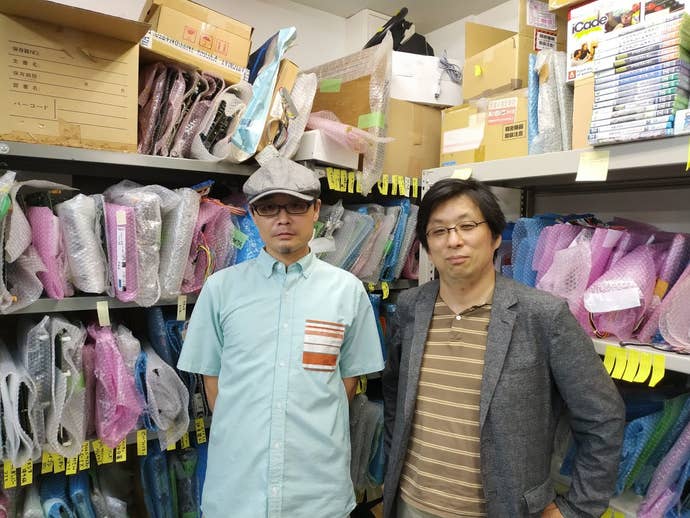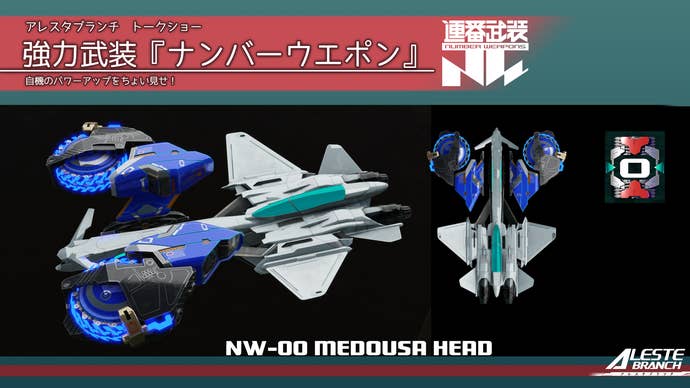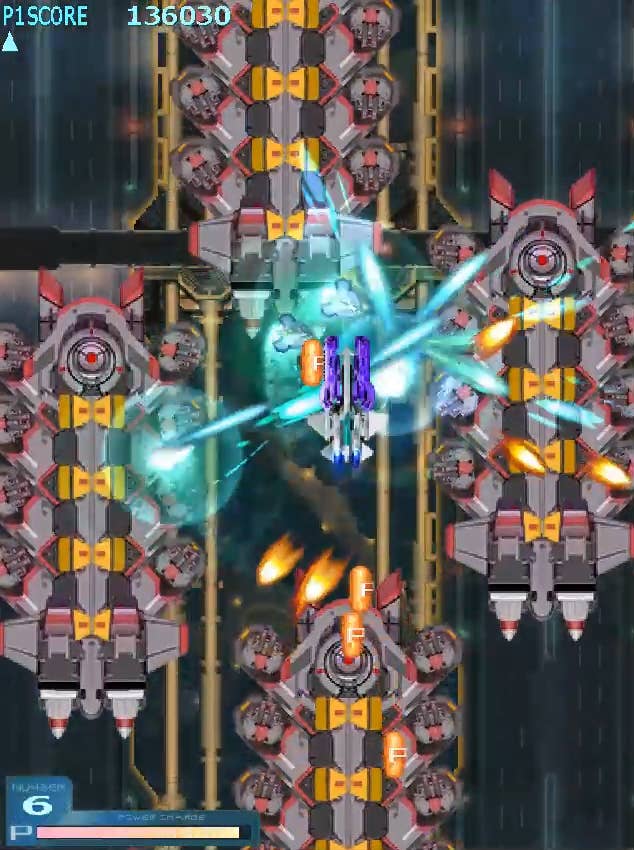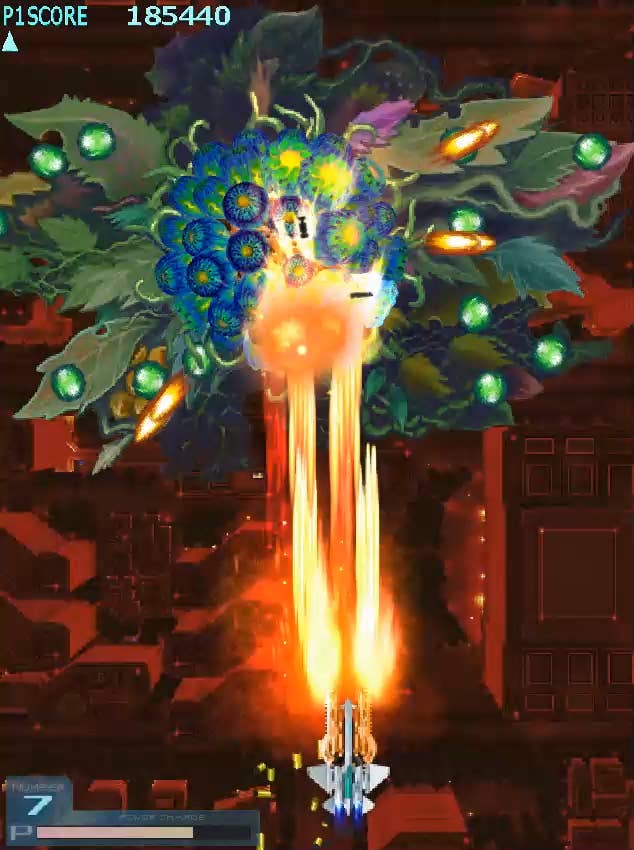M2 Shows Us Aleste Branch, the Triumphant Return of a Classic 8-Bit Shmup
Aleste is making a comeback from the studio that made Sega Ages, the ReBirth series, and more.
This article first appeared on USgamer, a partner publication of VG247. Some content, such as this article, has been migrated to VG247 for posterity after USgamer's closure - but it has not been edited or further vetted by the VG247 team.
This interview originally appeared in issue 315 of the German-language magazine M! Games. This is its first appearance in English.
Here's a great example of the care and detail retro developer M2 puts into its projects. Way back in the days of the PlayStation 2, M2 CEO Naoki Horii was working on a Sega Ages Collection featuring Fantasy Zone when he made a disappointing discovery: there was no proper arcade 16-bit version of Fantasy Zone 2. It had only ever been released on the Master System. So instead of just adding the 8-bit game to the collection, M2 invested its own time and money fully remaking Fantasy Zone 2 DX, adding multiple improvements to an already great game. That's how far M2 is willing to go. Now this small, dedicated company is releasing a new game from another classic shoot 'em up series, called Aleste Branch.
On September 7, M2 gave the public a first taste of Aleste Branch. At Taito Hirose Entertainment Yard (HEY), one of the nicest remaining arcades in Akihabara, the developers held a presentation for the new project. While it didn't show any screenshots or gameplay, it talked about things like difficulty and the design of the player's ship—the Aleste Dragoon—changing with different weapon-configurations. Attendees were also given an illustrated folder showing heroine Ellinor Waizen and could try out other shooting games, including Beep's Cotton for X68000, and M2's own ESP Ra. De. ? on PS4 and Switch—the latest title in its wonderful M2 Shot Triggers series.

So we also went the extra mile to pay M2 a visit in its office near Tokyo. We were greeted by CEO Naoki Horii, Game Designer Highma Fuyuno, and translator Ken Senda, and sat down between shelves full of jamma-boards, arcade machines, and old consoles. Between sips of cold, sugarless tea, we talked about M2 and its upcoming shooting game. But before getting to Aleste, one other important subject had to be brought up.
USgamer: Mr. Horii, when looking at the message to the players on the official website of M2, I could see a big Virtual Boy standing right next to you. Is that some sort of... message?
Naoki Horii, CEO: [laughing] No, the presence of a Virtual Boy in this picture is pure coincidence.
But do you have a certain affinity for the Virtual Boy?
NH: I like the Virtual Boy very much. For me, the Virtual Boy was the realization of "cyber" at that time.
So let's talk about Aleste then. What is, by the way, the proper pronunciation of the title?
NH: I don't know! I think we're going to choose the one that is pronounced the coolest and make it official.
The last game came out many, many years ago. Why make a new one now?
Highma Fuyuno, game designer: The first reason why we're making the new Aleste game now is because we love it. Besides that... Manabu Namiki, a composer who worked for us as the sound director until 2017, recently made friends with Keiji Takeuchi, a.k.a. KG Takeuchi—also a composer and one of those who wrote music for some of the Aleste games. The meeting inspired Mr. Namiki to suggest that M2 make an Aleste game, with the IP already in the company's possession. By coincidence, I came up to CEO Horii with a rudimentary plan for an Aleste game at around the same time. Mr. Horii felt as if there was some force of fate at play, and decided to go on with the plan. This was the beginning of what would later become Aleste Branch project.
How did M2 get hold of the Aleste IP?
NH: As you know, the original Aleste was an IP of the company Compile. But at one point, all the IPs held by Compile went to another company called Aiki. But when Aiki wasn't around anymore, the rights went to a company called D4E. And then we bought the Aleste IP from D4E. So now we have this IP.
What will the new game look like? Will it be pixelated or polygonal? 2D or 3D?
HF: In the early '90s, there was a movement where people tried to create graphics that looked like 3D using 2D technology. That was right before PlayStation came along; games like Super Thunderblade or Galaxy Force. Our concept for Aleste Branch is to recreate that look. One of the important requirements for this game is, since the market for shooting games is not that big, we can't spend money like on a huge blockbuster game, so we have to make it small and swift. That is one of our first requirements. The pixel art in the style of the Super Famicom looks great, but if we're going to make graphics in this style nowadays, it will take a lot of time, and time equals money. Today there are only few people who can do this style of graphic by hand, so going retro doesn't always mean going cheap. So to cut the cost, we are considering utilizing tools like Unity to make the development more cost-effective.

M2 is known for great ports of classic games, but this is an all new title. How do you approach that?
NH: Aside from ports, we have worked on Konami's ReBirth series: Castlevania, Contra, and Gradius ReBirth. There was also Sega's Fantasy Zone 2 Arcade Version. We have much experience in making new entries in classic series, so making the new Aleste is not really a new experience for us. Even when we are doing ports of classic games, we add something like the M2 Gadgets. For me, the difference between ports and a new game in a classic series is like the difference in the ingredients of various cocktails. If we do a port, we put in more old stuff; and when we make a game like Aleste Branch, there is more new stuff.
What can we expect in terms of difficulty?
HF: I have worked on shooting games before and there have been some very difficult games among them. From my experience, games with easier difficulty levels are enjoyed easily by more people; they have much more positive feedback. Especially in events where we could communicate with fans directly, there were many occasions where fans thanked us for making easier modes. Many people seem to feel isolated and estranged by too difficult games, and sometimes they feel apologetic about buying games that they can't really play. So I feel it's important for us to implement easy game modes that people can enjoy right away, and they can become better and enjoy more difficult game modes.
How many people are working on Aleste Branch?
HF: There are basically two people. I'm working on planning and graphic design. The programmer [Masato Yamanaka] is working on game design, too. Music is done by Mr. Takeuchi, the person who we mentioned before. I want more people! Let me elaborate about the programmer. This is his first time of working on a commercial product. I, however, have been working in the game industry for over 25 years. So one is really new to the industry, the other is in the industry for a long time. But that young programmer is the world's best player of a certain shooting game, and that balances it out again. In addition, he has a very accurate perception of what makes a good game as a player, and as a programmer, he can translate core features that work into the programming language. So he's a very good partner.
Are there elements that you would consider typical for the Aleste series?
NH: Aleste is a very multi-faceted series and from title to title, there are different features. But there is one common denominator in the whole series, and that is its anime-like qualities. In other words, that means the series is quick to catch up to the latest trends in the anime subculture and incorporate them into the new titles. In our new title, Aleste Branch, we are trying to incorporate current trends in the anime subculture and put in things that anime fans will quickly recognise and find interesting.


What can you tell us about the design of the main character?
NH: The design for the main character is done by an artist named Komatsu Eiji, who is regarded as a top-class artist in the genre of robots and bishojo/beautiful girls. The artist is very well-acquainted with the series and it's great for us to work with him. He's also an indie game developer and he released a rather renowned indie-shooting game for PC-98. He made all the graphics. The game is called Flame Zapper Kotsujin. Kotsu means Flame, Jin means Dust. So it's Bonedust.
What personal memories do you have from the Aleste series?
NH: I really like Aleste on the Master System. And also Mahou Daisakusen, which is called Sorcer Striker in the USA. There was a shooting game on NES called Zanac and it wasn't ported to Master System. But the first Aleste on Master System is basically a port of Zanac, which had its title changed. So it's a welcome release for those who were waiting for a release of Zanac on Master System.
Aleste on Master System is really, really hard.
NH: If you use weapon number 3, it's very easy. Mahou Daisakusen, Sorcer Striker, was made by the staff of Musha Aleste. When I first played in in the arcade, that was maybe in 1994, it wasn't marketed as a part of the Aleste series and it wasn't a Compile game either. But playing it feels exactly like Aleste, so I thought it was a Musha Aleste for arcade! We released the game as a part of the M2 Shot Trigger series on PS4 in Japan. Both Mahou Daisakusen and Musha Aleste were done by a programmer called Yuichi Toyama.
HF: Maybe it's hard for you in Germany to understand, but in Japan, there once was a feud between Sega and Nintendo users. I was one of the Sega people, so I had a difficult stance towards SNES games. I believed that in regards to shooting games, Mega Drive games were far better than SNES games. And in particular I thought, Musha Aleste was the best of the best. But then I found out about Super Aleste, which was made by Compile too, and seeing it was a huge shock for me. When I actually played it, I liked it so much, contrary to my beliefs, so I was very confused. That's what left the biggest impression on me.

I thought the SFC couldn't do fast action. I was surprised.
NH: It was work of a programmer named Jemini Hirono, and when he created Super Aleste, he thought exactly about how he could make a shooting game on SNES that doesn't slow down. That was exactly his objective.
When will Aleste Branch come out?
NH: In this case, we're going to answer differently. I'm the CEO, so I talk about my hope for the company, and Mr. Fuyuno is more grounded in reality. My answer is hopefully next spring, next March. March 2020. But maybe saying 2020...
HF: My answer is... sometime next year.
NH: Well, maybe saying March 2020 is not very realistic...
HF: By the way, the reason why our new Aleste is called Aleste Branch is because I like Contra: Hard Corps very much and the story in Hard Corps branches out after every level. That approach is one we take in Aleste Branch.
In late December, M2 is planning to show the first real footage of Aleste Branch. Until then, the screenshots shown here are the first images released worldwide. The series again seems to be heading in an all-new direction—which is a good thing, especially since it's now in the capable hands of M2. If its stellar work on Fantasy Zone 2, and the care it put into its M2 Shot Trigger series is any indication, there's no developer that could be trusted more with doing such a classic series justice.

